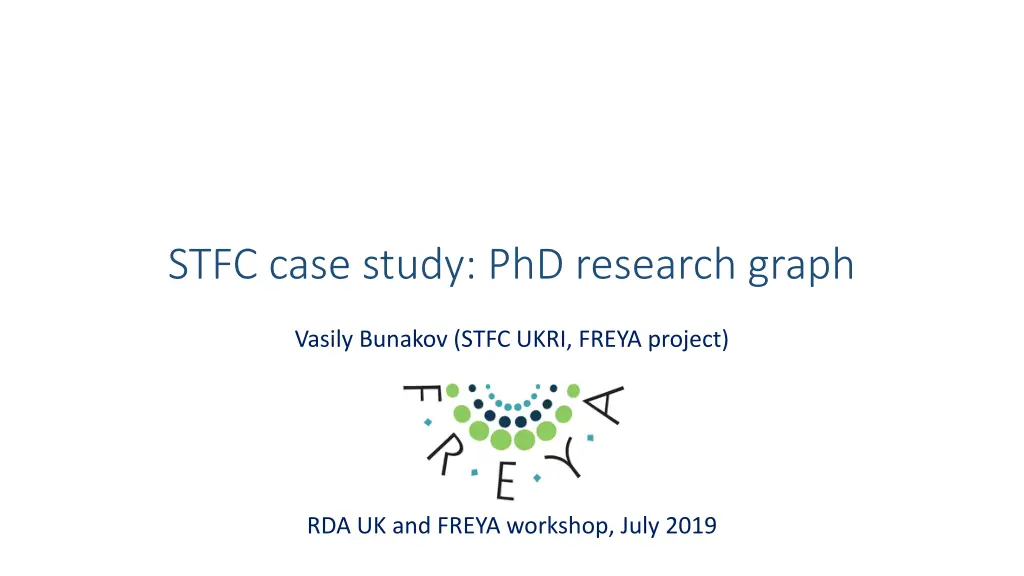
Enrichment and Cross-Repository Harmonization for Building a Knowledge Graph
"Explore how Science and Technology Facilities Council (STFC) collaborates with partners like British Library in integrating data sources, validating new PID services, and demonstrating the value of PID graphs through PhD research. Learn about the development of pilots in the FREYA project and the integration of disciplinary graphs for a common PID graph. Discover the importance of using PIDs for enriching and harmonizing records across repositories for building a comprehensive knowledge graph."
Download Presentation

Please find below an Image/Link to download the presentation.
The content on the website is provided AS IS for your information and personal use only. It may not be sold, licensed, or shared on other websites without obtaining consent from the author. If you encounter any issues during the download, it is possible that the publisher has removed the file from their server.
You are allowed to download the files provided on this website for personal or commercial use, subject to the condition that they are used lawfully. All files are the property of their respective owners.
The content on the website is provided AS IS for your information and personal use only. It may not be sold, licensed, or shared on other websites without obtaining consent from the author.
E N D
Presentation Transcript
STFC case study: PhD research graph Vasily Bunakov (STFC UKRI, FREYA project) RDA UK and FREYA workshop, July 2019
Science and Technology Facilities Council and its research facilities STFC funds and operates large scale instruments for the UK and visitor researchers in: - physics, astronomy - chemistry, materials - biology, medicine STFC research facilities: ISIS neutron and muon source www.isis.stfc.ac.uk Central Laser Facility www.clf.stfc.ac.uk Diamond Light Source (co-owned by STFC and Wellcome Trust) www.diamond.ac.uk
PhD research use case as an illustration of case- driven approach in general Collaboration: British Library and STFC are the FREYA partners and operate repositories that can be used for data integration Validation of new PID services and recommendations for Organizations and Instruments and supplying feedback for their improvement Demonstration of PID graph value in a disciplinary context Integration of a disciplinary graph in a common PID graph (federation of services) via reasonable interfaces
Data sources to integrate EThOS (British Library) Diamond DB ePubs (STFC) Researchfish Oxford RA Spiral (Imperial College) ChemSpider (Royal Society of Chemistry) DataCite GRID.AC
Enrichment and cross-repository harmonization of records as an incentive for building a knowledge graph with as much use of PIDs as possible MATCH (ethos:EThOS_Thesis)-[r:sameThesisAs]-(x) WHERE ethos.Funders IS NULL RETURN count(ethos) MATCH (ethos:EThOS_Thesis)-[r:sameThesisAs]-(x) WHERE ethos.Funders IS NOT NULL RETURN count(ethos) 454 150 Cases where STFC sponsored a PhD research (via monetary funding or via facilities grants-in-kind) but EThOS Funders is empty Where STFC is mentioned as a funder, another issue is observed: EThOS Funders is currently a free-text, so STFC can be referred to as: Science and Technology Facilities Council (STFC) Science and Technology Facilities Council Science & Technology Facilities Council Science and Technology Facilities Council (Great Britain) (STFC) STFC
Imperial College PhDs who experimented on STFC facilities
Another graph example (with connections to EThOS and ChemSpider)
Next step in data integration: extension of the PhD research graph with chemical information Match more ChemSpider records with EThOS records, to build a bigger seed PhD research graph Align this effort with the forthcoming upgrade of the EThOS IT infrastructure Devise a new workflow for chemical information recording by PhDs in a few good UK universities Sounds like a dedicated project that a UK funder could be interested in
Next step in service development: inclusion of the PhD research graph in a federation or services with a common GraphQL API See Martin Fenner s blogpost: https://doi.org/10.5438/bv9z-dc66 See also Jupyter notebooks: https://github.com/datacite/notebooks See also the section of PID Forum devoted to PID graphs: https://www.pidforum.org/c/pid-graph
PID graph as a (new kind of) infrastructure for Open Science Possible uses Possible data sources Gap analysis for repositories coverage STFC ePubs Diamond publications DB Records connection across repositories CCDC data Records enrichment EMBL-EBI data Entities disambiguation ChemSpider data Impact studies
Use case connections to the RDA groups RDA Persistent Identification of Instruments WG (results adoption phase) Open Science Graphs for FAIR Data IG (community review and then the actual works of the group) Research data needs of the Photon and Neutron Science community IG (intermittent activity)
UK dimension: RDA works in the national context Champion certain RDA outcomes and RDA ongoing effort in our organizations and disciplinary communities Offer RDA UK as a platform for networking with the EU and other international projects and initiatives Educate UK policy makers, and support continuous engagement with them Use RDA UK as a launchpad for the UK-funded projects
Thank you! Web: www.project-freya.eu Email: info@project-freya.eu Twitter: @freya_eu PID Forum: www.pidforum.org The FREYA project has received funding from the European Union s Horizon 2020 research and innovation programme under grant agreement No 777523
